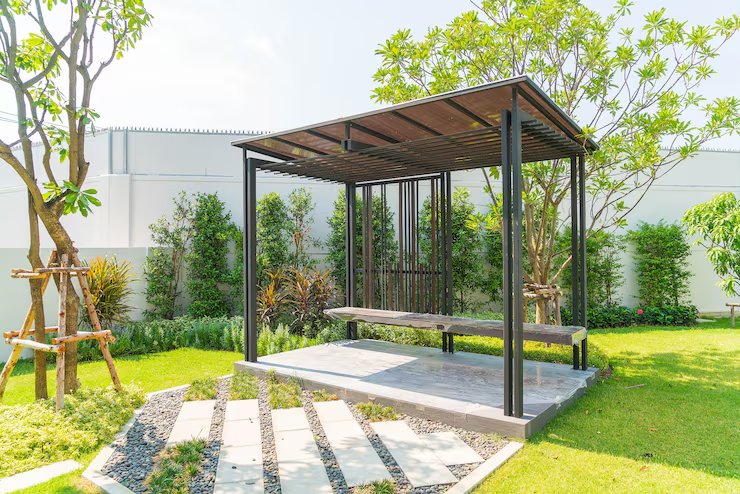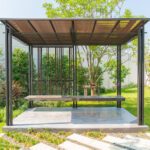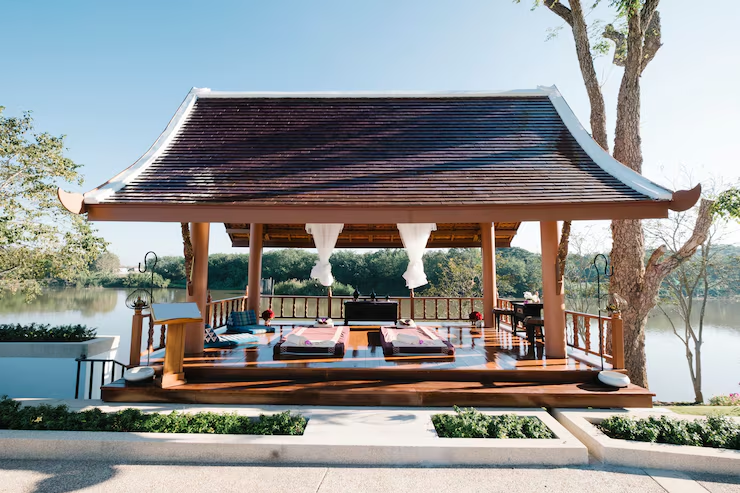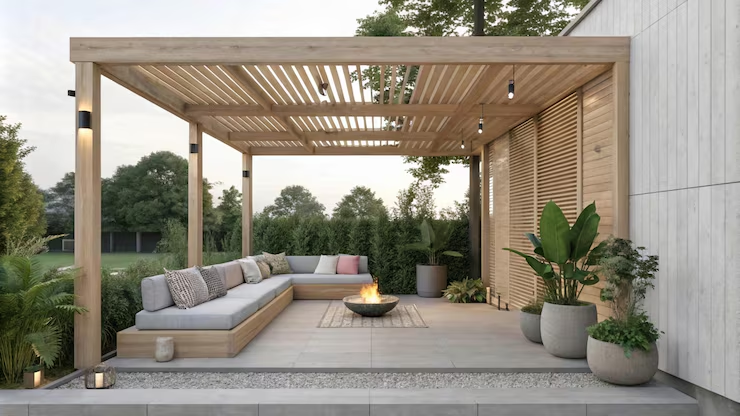Pergolas bring shade, style, and comfort to outdoor spaces, but their durability in high winds is an important factor to consider. From regional building requirements to material strength and smart installation, several details play a role in how well a pergola stands up against storms. Knowing the limits and maintenance needs helps ensure long-term safety and performance.
Here are key insights on codes, wind limits, and materials that improve pergola durability in high winds.
Table of Contents
Building Codes and Regulations
Materials That Resist High Winds
Design and Installation for Better Wind Resistance
Maintenance for Long-Term Durability
Enhance Outdoor Living in Connecticut with Durable Pergolas!
Key Takeaways
| ✔ Local codes set the safety standards for pergolas and ensure they meet wind load requirements. ✔ Most pergolas can withstand moderate winds, but proper design and anchoring increase their resistance. ✔ Wood, aluminum, steel, and composites each offer different strengths against high winds. ✔ Strong foundations, reinforced posts, and smart design choices make pergolas more wind-resistant. ✔ Regular inspections and upkeep help pergolas stay durable and safe through storm seasons. |
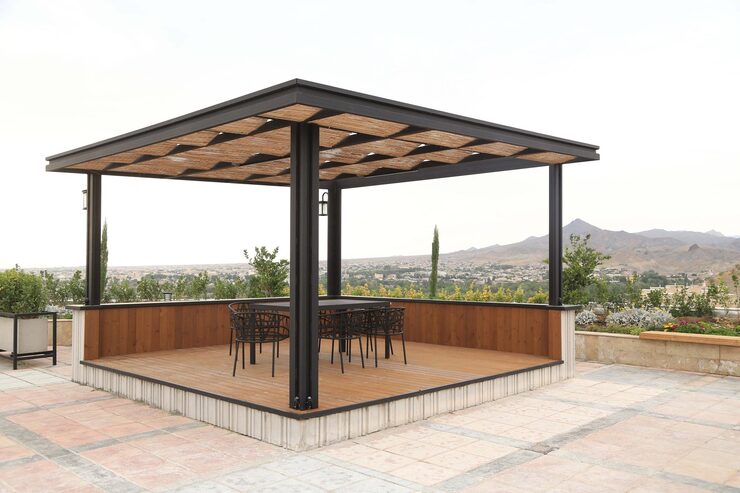
Building Codes and Regulations
Local building codes play a major role in how pergolas are built and how durable they are in high winds. These codes are created to keep structures safe and to reduce risks during storms. Homeowners and contractors need to be aware of the rules in their area before construction begins.
Local Building Codes Explained
Every region has its own set of building codes. These rules cover the type of structure, size, placement, and materials. For pergolas, codes are especially strict in areas with high winds, hurricanes, or tornadoes.
- Safety Standards: Codes ensure the pergola is strong enough to handle the local weather conditions without collapsing. They guide builders on the minimum strength of posts, beams, and connections. Following these standards protects both the structure and the people using it.
- Location Rules: Some codes set minimum distances from property lines or nearby buildings. These rules help prevent damage to neighboring properties if the pergola is damaged by strong winds. They also make sure the pergola does not block emergency access or utilities.
- Roofing Code Requirements for Wind: Roofing rules may apply if the pergola has a solid or partially covered top. These requirements define how materials must perform when exposed to wind pressure. They are designed to prevent roofing pieces from becoming hazards during storms.
Wind Load Requirements by Region
Regions with strong storms, like coastal areas or the Midwest, have higher requirements for wind loads. A pergola must be designed to handle the average and extreme wind speeds recorded in that zone.
- Regional Limits: Roof wind speed limits are written into codes and vary by state, city, or county. They often state the maximum wind speed in miles per hour a structure must withstand. These limits help ensure that pergolas remain stable even in powerful gusts.
- Engineering Standards: Builders often use charts and wind zone maps to calculate how much wind can a pergola withstand. These tools help determine the right post size, spacing, and anchoring method. By using these standards, pergolas are built to match real-world conditions.
- Stronger Foundations: In high-wind zones, codes may require reinforced anchors or deeper footings for pergolas. This added support helps keep the structure from lifting or shifting in storms. It also reduces long-term wear caused by repeated exposure to strong winds.
Importance of Permits and Inspections
Permits are not just paperwork—they confirm the pergola meets safety rules. Inspections make sure the structure is built as planned and can stand up to wind pressure.
- Building Permits: Permits are needed before construction begins and show that plans meet local safety codes. They serve as legal approval to build, giving homeowners peace of mind. Without permits, homeowners risk fines and possible removal of the pergola.
- On-Site Inspections: Inspectors visit during or after construction to confirm the pergola is built to code. They check anchors, bolts, and structural connections for proper installation. Passing inspections means the pergola is officially cleared for safe use.
- Protection for Owners: Following the permit and inspection process also protects homeowners from future problems. Roof warranty wind coverage may not apply if codes are ignored or permits are skipped. Meeting these requirements also helps avoid disputes with insurance after storm damage.
Wind Limits for Pergolas
Pergolas can be beautiful outdoor structures, but they must be strong enough to handle wind. Many homeowners wonder: how much wind can a pergola withstand? The answer depends on how the pergola is built, what materials are used, and how it is anchored to the ground or a structure.
Typical Wind Speeds Pergolas Are Designed to Withstand
Most pergolas are built to handle average weather conditions, but stronger winds can create risks. Builders and manufacturers often use guidelines similar to roof wind speed limits to help design safer structures. Local inspectors also check roofing code requirements for wind, which can apply to pergolas in areas with frequent storms.
- Reinforced Designs: Some pergolas, especially those with steel or aluminum frames, can resist higher wind speeds. In coastal or storm-prone regions, reinforced pergolas provide an extra layer of safety. They are often recommended for areas where high winds are a seasonal threat.
- Lightweight Structures: Pergolas made from light vinyl or thin wood are less resistant. These designs may shift, bend, or even collapse under heavy gusts if not secured. While they are affordable and easy to install, they are not ideal for regions with high wind activity. In many cases, they require extra reinforcement or frequent maintenance to stay safe.
Factors That Affect Wind Resistance
The strength of a pergola in windy conditions is not the same for every design. Several important factors decide how much force it can handle.
- Size Of The Pergola: Larger pergolas catch more wind. The bigger the surface area, the more wind pressure the structure will face. This makes oversized pergolas riskier unless reinforced with strong supports. Choosing the right size for the location can help reduce strain during storms.
- Overall Design: Open-roof designs let wind pass through. By allowing airflow, these pergolas face less overall pressure. In contrast, solid-roof or louvered pergolas often need stronger beams and anchors to prevent damage. The choice of design plays a big role in long-term durability.
- Anchoring and Foundation: Strong connections to concrete or a wall make a pergola more secure. Without a solid base, even the strongest materials can fail under stress. Anchoring posts into deep concrete footings or attaching them to the home improves stability. Weak or shallow anchors may cause the pergola to lift during high winds.
- Material Choice: Stronger metals and hardwoods resist bending and breaking. These materials give the pergola better strength and lifespan in areas with tough weather. Lighter materials like untreated pine or vinyl may wear down faster under the same conditions. Investing in stronger materials can prevent costly repairs later.
Difference Between Freestanding vs. Attached Pergolas
How the pergola is installed makes a big difference in wind durability, just as proper placement and support are essential when using wind-resistant roofing materials for lasting protection.
- Freestanding Pergolas: These stand on their own with four posts. Because they are exposed on all sides, they take on more wind pressure. A strong foundation with deep-set posts is critical for freestanding designs. Without it, these pergolas are more likely to tilt or shift in storms.
- Attached Pergolas: These connect directly to a house or wall. The building provides extra support, reducing the stress on the pergola’s posts. Attached pergolas are generally more stable in high winds if the house itself is structurally sound. They also tend to be easier to secure with fewer anchoring points.
- Hybrid Designs: Some pergolas use both wall connections and extra footings. This blend provides the best of both worlds by combining stability with flexibility. Hybrid pergolas can often withstand stronger winds compared to freestanding ones. They are popular in storm-prone areas where safety and strength are top priorities.
Materials That Resist High Winds
When building a pergola in an area with strong winds, the choice of material plays a big role in how long it will last and how safe it will be. Each option has different strengths and weaknesses, much like wind-resistant roofing materials, and understanding these differences can help guide the best choice.
Wood: Strengths and Weaknesses
Wood has a traditional and natural look, but it may not always be the best for high-wind areas.
- Strength: Wood is heavy and can be very sturdy when properly anchored, giving pergolas good stability in normal wind conditions.
- Weakness: Wood can warp, crack, or rot over time, especially if not treated. In very strong winds, large wooden beams may still shift or break if not reinforced.
Aluminum: Lightweight Yet Durable
Aluminum is one of the most popular choices for wind-prone areas because it balances strength with lightness.
- Durability: Aluminum does not rust and can resist many weather conditions. It is often combined with powder coatings for extra protection.
- Weight Advantage: Even though it is lightweight, aluminum can be engineered to handle strong winds when installed correctly.
Steel: Strong, But May Need Rust Protection
Steel pergolas are very strong and can handle high wind loads, making them suitable for coastal and storm-prone regions.
- Strength: Steel is heavier and stronger than aluminum and wood, offering superior wind resistance, while aluminum alloys are lighter but have lower strength compared to steel.
- Protection Needed: Without the right coatings or galvanization, steel can rust over time, especially in humid or salty air.
Vinyl and Composites: Low Maintenance But Less Sturdy
Vinyl and composite pergolas are chosen for their clean look and easy upkeep, but they have limits in extreme wind.
- Low Maintenance: These materials do not rot, chip, or require heavy sealing like wood.
- Wind Limitations: Vinyl and composites are lighter and more flexible, which means they may bend or break under high wind pressure.
| Material | Strengths | Weaknesses | Wind Resistance | Maintenance Needs |
| Wood | Heavy and stable, natural look | Can warp, crack, or rot; weaker in extreme winds | Moderate, depends on reinforcement | High, requires sealing or treatment |
| Aluminum | Lightweight, durable, rust-resistant | May dent under heavy impact; needs secure installation | Good, when engineered and installed properly | Low, occasional cleaning |
| Steel | Very strong, handles high wind loads | Can rust if not coated or galvanized | Excellent, often meets strict wind codes | Medium, rust protection required |
| Vinyl/Composites | Low maintenance, clean appearance | Less sturdy, may bend or break in high winds | Fair to poor, limited in extreme winds | Very low, minimal upkeep |
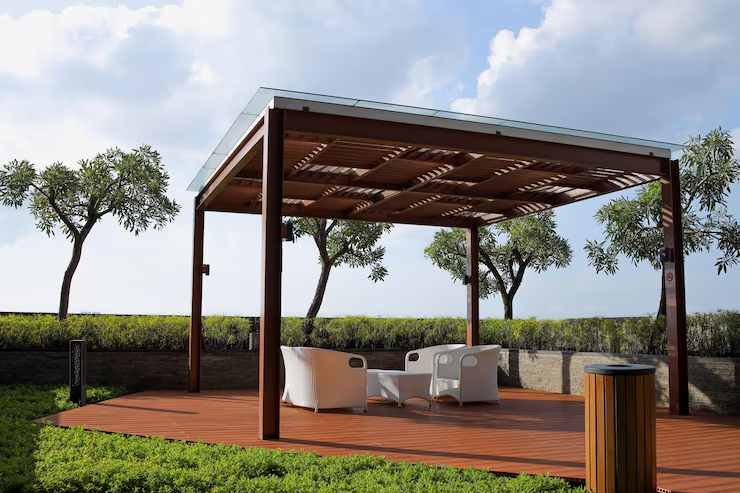
Design and Installation for Better Wind Resistance
When a pergola is built in an area with strong winds, its design and installation play a major role in how long it will last. The way it is anchored, the strength of the posts, and even the shape of the roof can determine how much wind a pergola can withstand.
Importance of Secure Anchoring and Foundation
A pergola that is not firmly anchored can shift, tilt, or even collapse during storms. A solid foundation ensures the structure can handle sudden gusts.
- Concrete Footings: Anchors set into concrete give pergola posts a strong base that resists lifting and shifting.
- Ground Screws: Heavy-duty ground screws can work as an alternative in some soils, holding posts firmly without deep digging.
- Reinforced Brackets: Metal brackets that secure posts to the foundation add extra stability and prevent wobbling.
Benefits of Reinforced Posts and Beams
Thicker posts and stronger beams provide the skeleton that supports the pergola against high winds. Choosing durable materials and proper sizes can make the difference between a stable structure and one that fails under stress.
- Heavy-Duty Posts: Larger posts, such as 6×6 instead of 4×4, add strength and help resist bending under pressure.
- Cross Beams: Extra beams running across the structure reduce sway and distribute weight more evenly.
- Steel Connectors: Reinforced metal joints improve the connection points, which are often the weakest parts in high winds.
Impact of Pergola Shape and Roof Style on Wind Flow
The way a pergola is shaped and how the roof is designed affect how wind moves around it. Some designs create resistance, while others allow air to pass through more easily.
- Open Louvered Roof: Adjustable slats can be tilted open to let wind pass through, reducing pressure on the structure.
- Sloped Roof Design: A slight pitch helps guide wind over the pergola, similar to roofing code requirements for wind that apply to buildings.
- Aerodynamic Shapes: Rounded edges or curved elements can lower wind drag compared to flat, boxy shapes.
Maintenance for Long-Term Durability
A pergola that is built to last needs more than strong materials and good design. Ongoing care plays a big role in how well it stands up to time and strong winds. Simple checks and timely maintenance help prevent problems before they turn into costly repairs.
Regular Inspection of Fasteners, Joints, and Anchors
A pergola’s stability depends on how well its parts stay connected. Strong winds can loosen fasteners and weaken joints over time, making the structure less safe.
- Check Fasteners: Bolts, screws, and nails should be tight and free from rust or bending. Loose fasteners reduce stability, especially when asking how much wind can a pergola withstand.
- Look at Joints: Wooden or metal joints should not have gaps or cracks. Weak joints can fail under pressure when wind speeds rise above normal roof wind speed limits.
- Inspect Anchors: Posts should remain firmly secured in the ground or concrete. Wobbly anchors increase the risk of damage during storms.
Protecting Materials from Rot, Rust, or Wear
Different materials react to weather in different ways. Protecting them helps extend the life of the pergola and keeps it more resistant to high winds.
- Wood Treatment: Apply sealant or stain to prevent moisture damage. Untreated wood can rot, which reduces strength against strong gusts.
- Metal Care: Steel and aluminum may resist high winds, but they need protection from rust or corrosion. Coatings or paint help keep them durable. Choosing wind-resistant roofing materials for overhead structures adds extra protection.
- Composite and Vinyl: These materials are low-maintenance, but they should still be checked for cracks or brittleness, especially before storm seasons.
Seasonal Checks Before Storm Seasons
Storm seasons bring stronger winds and heavier rainfall. Preparing a pergola in advance helps prevent unnecessary damage.
- Pre-Storm Inspection: Before storm season, check all connections, posts, and any attached covers or shades. This makes sure the pergola meets basic roofing code requirements for wind safety.
- Roof Attachments: If the pergola has a roof or partial cover, confirm that it is secure and rated for roof wind speed limits. Some roof warranty wind coverage may require proof of maintenance.
- Clear the Area: Remove loose objects around the pergola that could hit and damage it in strong winds.
Frequently Asked Questions (FAQs)
Pergolas can withstand wind if they are built with strong materials and anchored securely. The amount of wind they can handle depends on design, size, and location. Freestanding pergolas usually need extra reinforcement compared to attached ones. Proper installation helps them stay stable in windy conditions.
A pergola can be protected by securing it with deep anchors, reinforcing posts, and checking joints regularly. Using wind-resistant materials like aluminum or treated wood helps improve strength. Adding diagonal bracing and keeping the structure low to the ground can reduce wind pressure. Seasonal inspections before storms are also important.
Yes, a pergola can hold a swing if it is designed and reinforced to carry the extra weight. The beams and posts must be strong, usually made of steel or heavy wood. Proper anchoring is essential to prevent tipping or movement. Always check the weight capacity before attaching a swing.
A pergola can be anchored by securing posts into concrete footings or using ground anchors. Metal brackets and bolts help fasten the structure tightly to a stable base. The deeper the foundation, the stronger the resistance to wind. Regular checks of anchors and fasteners help keep it secure.
Yes, a pergola can stay up all year if it is built with durable materials and maintained properly. Weather-resistant wood, aluminum, or steel hold up well through changing seasons. Regular inspections for rot, rust, or loose joints keep it safe. Covering or reinforcing the structure before storm seasons adds extra protection.
Enhance Outdoor Living in Connecticut with Durable Pergolas!
Connecticut homeowners can enjoy added comfort and style with a pergola designed to handle local weather conditions. Durkin’s provides expertly crafted pergolas built with strength and durability in mind, making them reliable even in areas with strong winds and seasonal changes. With the right materials and secure installation, these pergolas remain steady and beautiful year-round, offering lasting value for outdoor spaces in Connecticut. Discover the difference that comes with trusted craftsmanship and weather-ready design.
Contact Durkin’s today to learn more and get started on a pergola built to last in Connecticut.

